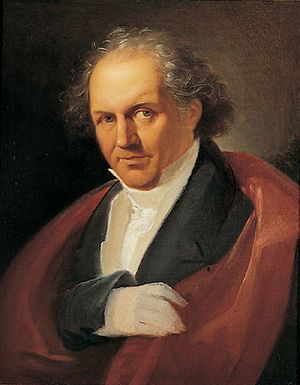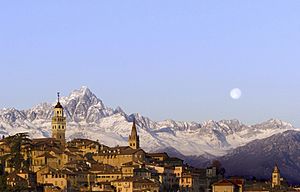Giambattista Bodoni facts for kids
Giambattista Bodoni (born February 16, 1740 – died November 30, 1813) was a famous Italian printer, typographer, and type designer. He lived and worked in Parma, Italy. Bodoni created many typefaces, which are styles of letters used in printing. He was known for making letters with strong contrasts between thick and thin lines.
Bodoni's printing style was clean and simple. He used wide margins around his text and rarely added pictures or decorations. His work was very precise and detailed. Many people admired his designs, and they became more popular than those of French designers at the time. Today, several modern typefaces are named "Bodoni" after him. They are often used for headlines and titles.
Contents
Exploring Bodoni's Life and Work
Early Years in Saluzzo (1740–1758)
Giambattista Bodoni was born in Saluzzo, a town in Italy near the mountains. He was the seventh child in his family. His father and grandfather were both printers in Saluzzo. As a child, Bodoni played with his grandfather's old printing tools.
He learned printing from his father and showed a natural talent for it. He was also very ambitious. At 17, he decided to travel to Rome. He wanted to become a famous printer there. He left his hometown on February 8, 1758.
Learning in Rome (1758–1766)
In Rome, Bodoni found a job at a special printing press. This press belonged to the Vatican's missionary group, called the Sacra Congregatio de Propaganda Fide. He worked as an assistant, helping to set type for printing.
Bodoni quickly became very good at his job. He was especially skilled with different languages from the Middle East and Asia. He even studied Hebrew and Arabic at a university in Rome. Soon, he became the main typesetter for books in foreign languages.
His supervisors were very happy with his work. They even let him add his name to some of the books he helped print. Bodoni then started making his own punches, which are tools used to create letter shapes for printing. After eight years, he was well-known for his amazing skills. However, he became sick and had to return home to Saluzzo to get better.
Working in Parma (1768–1813)
After recovering, Bodoni began working with his father again. Meanwhile, in Parma, the young Duke Ferdinando and his prime minister wanted to start a royal printing press. They needed a talented person to set it up. A librarian who knew Bodoni from Rome suggested his name. In February 1768, Bodoni moved to Parma to begin this big project.
He started working right away. He asked his brothers to come help him, and one of them, Giuseppe, stayed with him for over 30 years. Bodoni bought everything needed for a top-quality printing business. This included presses, paper, ink, and tools. He also ordered type from a famous French printer named Fournier.
At first, Bodoni used Fournier's letters. But soon, he started making his own versions of them. Eventually, he developed his unique printing style. His first big project in Parma was a beautiful book celebrating the Duke's wedding. This book showed Europe that Bodoni was a printer to watch.
He continued to print many important books and documents for the court. He also created books that showed off his typefaces. His most famous work, the Manuale tipografico (Manual of Typography), was published after he died.
Other cities and important people tried to convince Bodoni to leave Parma. But in 1791, the Duke of Parma offered Bodoni his own private press. This meant Bodoni could print whatever he wanted for anyone he chose. Bodoni was happy in Parma and had just married Margherita Dall’Aglio. He stayed there for the rest of his life, running both the royal and his private presses.
In his later years, Bodoni printed many classic books by famous authors like Horace and Homer. Napoleon was so impressed by Bodoni's Iliad that he gave him an award and a lifelong payment.
Bodoni was not interested in politics. When the Duke of Parma died and the French took over, Bodoni continued his work. His fame grew, and people from all over came to see him. Even Benjamin Franklin, who was also a printer, sent him a fan letter. In 1805, Napoleon and Empress Josephine visited Parma and wanted to meet Bodoni. Sadly, Bodoni was sick that day and could not see them.
In 1806, Bodoni created an amazing book called Oratio Dominica. It contained the Lord's Prayer in 155 languages. He had been challenged by Pope Pius VII to make a book even better than a similar one he had seen in Paris.
Bodoni passed away on November 30, 1813. He was working on a series of French classic books when he died. His wife, Margherita Dall’Aglio Bodoni, finished his projects. Five years after his death, she published his masterpiece, the Manuale tipografico of 1818. This huge book was over 600 pages long and showed off 265 pages of different letter styles. It also included 181 pages of Greek and Asian characters, and over a thousand decorations.
Bodoni Museum
The Museo Bodoniano opened in Parma, Italy, in 1963. It is located in the same building as the Biblioteca Palatina, a famous library. The museum shows many examples of Bodoni's amazing printing work.
Notable Editions by Bodoni
- Descrizione delle Feste Celebrate in Parma per le Auguste Nozze… (1769?)
- Epithalamia Exoticis Linguis Reddita (1775)
- Santorini's Anatomici summi septemdecim tabulae… (1775)
- Aminta (1780)
- The Works of Homer (1791)
- Virgil's Aeneid (1793)
- The Divine Comedy (1795)
- Didymi Taurinensis de Pronuntiatione Divini Nominis (1799)
- Oratio Dominica (1806)
- Homer's Iliad (1808)
- Cimelio… (1811)
- Oeuvres Poétiques de Boileau (1811)
- Manuale tipografico (1818, published after his death)
Images for kids
See also
 In Spanish: Giambattista Bodoni para niños
In Spanish: Giambattista Bodoni para niños
- Bodoni, a series of typefaces named after him
- Amoretti Brothers






